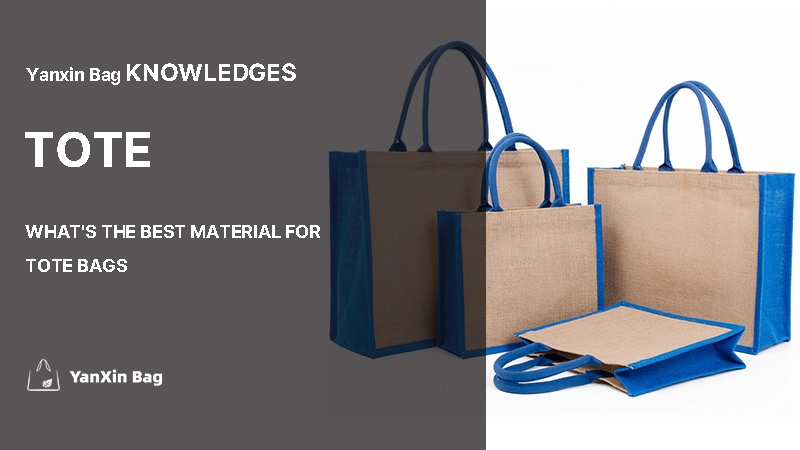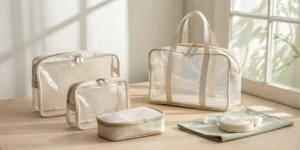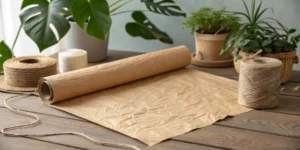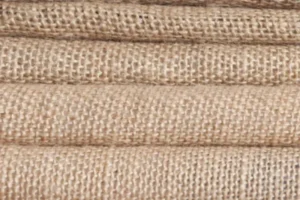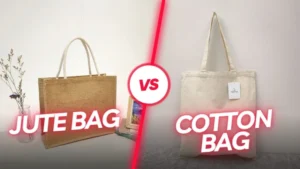Last Updated on 2025-06-15 by Jacky Zhou
Tote bags are versatile and practical accessories, widely used for shopping, commuting, and travel. With their spacious design and sturdy handles, they have become essential items in many people’s daily lives. However, not all tote bags are the same—they come in a variety of materials, each with its unique advantages. Whether you are looking for an eco-friendly, durable, or stylish option, the material of a tote bag can greatly impact its usability. This article will explore the most common tote bag materials and their unique features to help you find the perfect tote bag for your needs.
The choice of material for a tote bag directly affects its functionality and user experience. Non-woven fabric is widely used for shopping bags and promotional bags because it is lightweight, durable, and inexpensive. Cotton and canvas are favored for their natural, eco-friendly, and durable qualities. In particular, canvas, with its excellent abrasion resistance and strength, is the top choice for high-demand tote bags. Tyvek paper, known for its waterproof properties and unique texture, has become a new favorite in the fashion world. Polyester is lightweight and durable, making it suitable for creating tote bags that require a thinner material, offering strong versatility and adaptability. Each material has its unique advantages, and consumers can choose the most suitable tote bag material based on their needs.
After getting a basic understanding of the characteristics of different materials for tote bags, we will now take a deeper look at these materials and analyze their features to help you make the best choice.
What Is A Tote Bag?
A tote bag is a large, multipurpose bag with a simple open design and two handles on the sides for easy carrying by hand or on the shoulder. It can hold various items, such as laptops, books, cosmetics, or groceries. Due to its practicality and versatility, tote bags are commonly used for shopping, commuting, and travel, making them the perfect combination of sustainability and style.
What’s the History of Tote Bags?
The history of the tote bag dates back to the 17th century when the word “tote” meant “to carry” or “to haul.” In the 19th century, “tote” transitioned from a verb to a noun, referring to a large bag. The modern tote bag originated in the 1940s with the canvas bags introduced by LL Bean, which became popular for their durability and laid the foundation for today’s tote bags. In the 1960s, LL Bean revamped the tote bag with a more fashionable design, inspired by designer Bonnie Cashin. The tote bag gradually became a stylish item. By the 1980s, tote bags had become a cultural symbol, especially the iconic canvas bags from The Strand bookstore. Since the 2010s, tote bags have become a symbol of both fashion and environmental consciousness in daily life. Today, tote bags come in a wide variety, from simple canvas bags to designer styles, showcasing their diversity and timeless appeal.
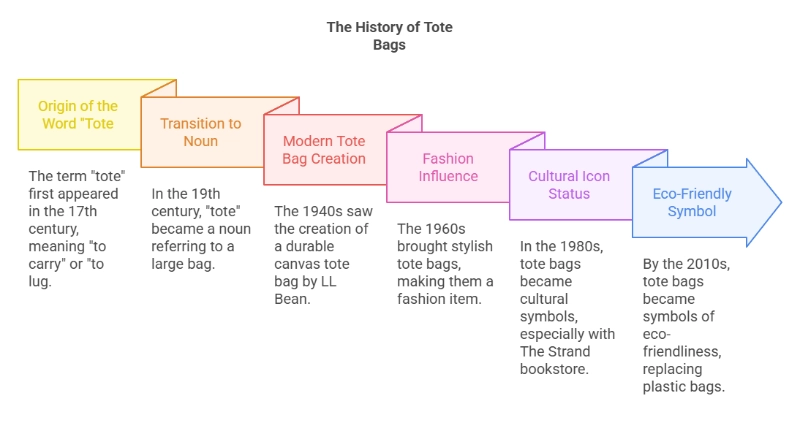
8 Popular Tote Bag Materials:
Affordable Tote Bag Material: Non-Woven Fabric
Non-woven fabric is a synthetic material made by bonding fibers such as polypropylene (PP) or polyester (PET) through heat pressing or chemical treatment. Unlike traditional woven fabrics, it does not require weaving threads together, which makes it lightweight, flexible, and inexpensive.
This cost-effective material is widely used for shopping bags, tote bags, storage bags, and even disposable items like pillows, towels, masks, and linings.
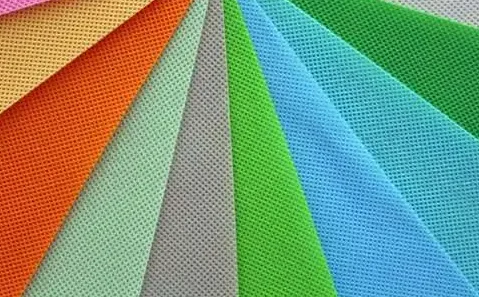
Key Advantages of Non-Woven Tote Bags:
Excellent Printability
The surface is smooth and suitable for various printing methods such as screen printing or heat transfer. This allows for vibrant, sharp, and detailed designs, making it ideal for logos, patterns, and promotional branding.
Reusable and More Eco-Friendly Than Plastic Bags
Although made from synthetic plastics, non-woven bags are more durable and reusable than traditional disposable plastic bags. When reused and recycled properly, they significantly reduce environmental impact.
Easy to Clean
Most stains can be wiped off with a damp cloth. Even with repeated use, the bags retain a tidy, presentable appearance, which is ideal for everyday applications.
Dust & Stain Resistant
The fabric’s structure naturally repels dust and grime, helping the bag maintain a cleaner look over time.
Cost-Effective
Non-woven fabric is inexpensive to produce and suitable for mass production. It offers a budget-friendly solution for businesses aiming to offer eco-conscious packaging.
Main Disadvantages of Non-Woven Fabric Tote Bags:
Prone to Wear and Tear
While relatively durable, it is less resistant to heavy loads or frequent friction compared to canvas or cotton. Using thicker materials and reinforced stitching can improve durability.
Slow Degradation
Non-woven fabric is not biodegradable and, if not properly recycled, contributes to long-term plastic pollution in landfills and oceans.
Microplastic Risk
Repeated usage and cleaning may cause microplastic shedding, which can enter the environment — particularly problematic in aquatic ecosystems.
Cost-Effective and Durable Tote Bag Material: Polyester
Polyester is a synthetic fiber derived from petroleum-based resources. Known for its strength and longevity, polyester is widely used in tote bags, apparel, home textiles, and industrial materials. It offers a great balance of durability, affordability, and versatility, making it ideal for everyday and commercial use.
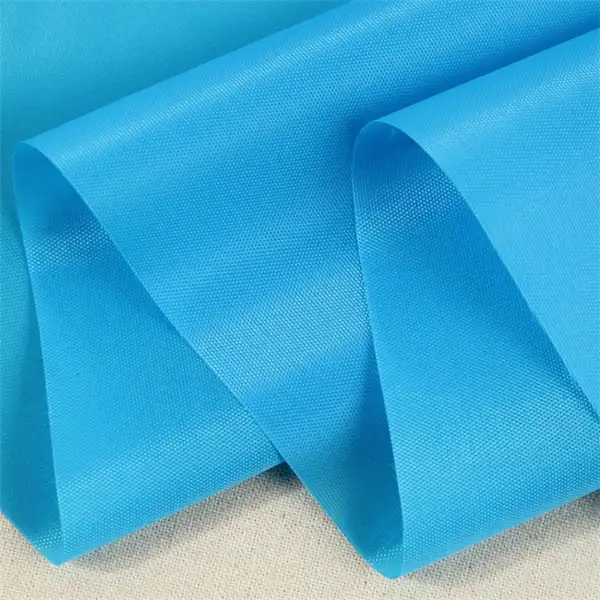
Key Advantages of Polyester Tote Bags:
Lightweight and Wrinkle-Resistant
Polyester is naturally light, making it easy to carry without adding bulk. It resists wrinkles and creases, helping bags maintain a neat, structured appearance over time.
Stain-Resistant and Easy to Maintain
Thanks to its synthetic nature, polyester repels many common stains. Most spills can be wiped away, and it holds up well through machine washing with minimal care.
Durable and Tear-Resistant
The fiber’s strength gives polyester bags excellent resistance to tearing, stretching, and daily wear, even under heavy use. This makes it suitable for travel bags and shopping totes.
Mold, Mildew, and Pest Resistant
Polyester resists damage from moisture, insects, and biological growth. This makes it an ideal material for storage or use in damp or outdoor environments.
Highly Dyeable
Polyester absorbs color evenly during high-temperature dyeing, resulting in rich, vibrant shades and long-lasting print clarity—perfect for personalized or promotional designs.
Budget-Friendly
Compared to natural materials, polyester is cheaper to produce and buy, making it a cost-effective choice for businesses and bulk production.
Compact and Portable
It folds down easily without losing structure, which is great for tote bags that need to be stored in small spaces or carried on-the-go.
Main Disadvantages of Laminated Tote Bags:
Low Heat Resistance
Polyester melts when exposed to high temperatures or open flames. It should be kept away from heat sources to prevent damage or fire hazards.
Non-Biodegradable
One major environmental concern is its long decomposition time. Polyester can persist in ecosystems for hundreds of years if not recycled properly.
Potential Microplastic Pollution
With frequent washing and use, polyester may shed microplastics, which can enter waterways and harm marine life. This makes sustainable handling and proper disposal especially important.
Best Materials for Printing Tote Bags: Laminated Bags
Laminated tote bags are made from base materials like non-woven fabric, PP woven, or RPET, and feature an additional thin film coating. This lamination process enhances the bag’s surface—making it smoother, more durable, and ideal for high-quality printing. It also improves water resistance and overall aesthetics, making laminated bags a favorite for both branding and retail purposes.
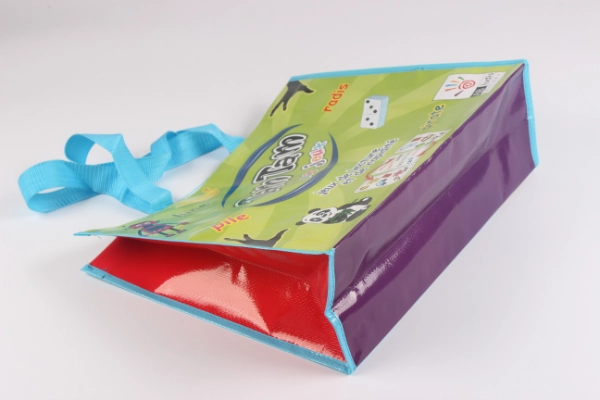
key advantages of laminated tote bags:
Waterproof and Dustproof
The laminated film prevents moisture and dust from penetrating the bag. This makes it suitable for use in humid or wet environments, such as supermarkets, grocery stores, or outdoor markets.
High-Quality Print Surface
The smooth laminated finish allows for crisp, vibrant, and high-resolution prints. Logos, graphics, and brand visuals stand out clearly, making laminated bags a powerful tool for marketing and promotions.
Enhanced Visual Appeal
Glossy or matte laminated finishes give the bag a premium, modern look. Whether for fashion, branding, or retail, this elevated appearance helps draw consumer attention and boosts perceived value.
Easy to Clean
Dirt and stains can be easily wiped off the laminated surface with a damp cloth. This makes laminated bags ideal for frequent daily use and extends the usable life of the product.
Main Disadvantages of Laminated Tote Bags:
Not Washable
Laminated tote bags are typically not suitable for machine washing. Washing can cause the laminated layer to peel off or get damaged, affecting the bag’s waterproofness and appearance. It’s recommended to gently wipe stains with a damp cloth.
Possible Setup Fees
If gravure printing is used, there may be setup fees. However, mass production can significantly reduce the impact of setup costs on the price.
Slightly Higher Price
If digital printing without plates is used, the prints are beautiful and don’t require setup fees, but the printing costs are higher than traditional gravure printing. This is more suitable for small-batch orders.
Not Recommended for Folding
Frequent folding over time can cause the laminated layer to peel off, affecting the bag’s appearance. Especially with high-frequency use, folding can accelerate the wear of the laminated surface, leading to a decrease in the overall quality of the bag. Therefore, it is not recommended to fold laminated tote bags for extended periods or frequently.
Perfect Choice for Everyday Use: Canvas
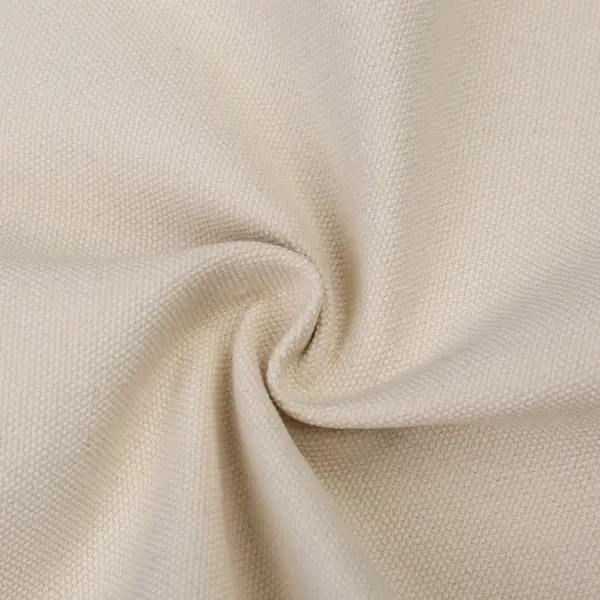
Canvas is the perfect choice for everyday use due to its natural material and excellent durability. It is widely used in various types of bags. Canvas is flexible and strong, able to withstand heavier items without tearing or losing shape.
Canvas bags are not only practical but also eco-friendly, making them an ideal option for those who want a durable and sustainable product. They can be used for shopping, work, or as a fashion accessory, offering both functionality and style. Canvas tote bags are perfect for use as shopping bags, travel bags, and other everyday purposes.
Main Advantages of Canvas Tote Bags:
High Durability: Canvas bags are very strong and can withstand heavy items and frequent use without tearing or wearing out. They are ideal for everyday shopping, travel, and carrying heavy loads, making them highly durable and multifunctional.
Water-Resistant Treatment: While canvas bags are not inherently waterproof, they can be treated with coatings to improve their water resistance. This feature makes canvas bags suitable for outdoor activities, not only stylish but also adaptable to various weather conditions.
Natural Appearance: The natural fiber texture of canvas gives it a unique and earthy feel, with soft colors and a comfortable touch. Its simple and rustic look is perfect for people who prefer a minimalist, natural style, reflecting a lifestyle in harmony with nature.
Waste Reuse: If a canvas bag is no longer needed, it can be repurposed into other useful items. For example, old canvas bags can be used for DIY projects, transformed into unique home decorations, or even repurposed as plant containers, reducing waste and extending their life.
Disadvantages of Canvas Tote Bags:
Heavier Weight: Compared to lighter materials like nylon or polyester, canvas bags tend to be heavier due to the thickness of the fabric. This can make them bulky when carrying many items, especially when walking or traveling for long periods.
Potential Shrinkage: Some untreated canvas materials may shrink after washing, so care should be taken in cleaning methods to avoid the bag losing its shape or size.
Fading: Over time, and after frequent washing or sun exposure, the color of canvas bags may fade, affecting their appearance. This is especially noticeable in dark-colored or printed canvas bags.
Absorbent: While canvas is breathable, it is also absorbent. If the bag gets wet from rain, it may take a long time to dry.
Storage Space: Canvas bags tend to take up more storage space when not in use, especially thicker versions. However, thinner canvas bags (like light cotton ones) are easier to fold and store, which can help address this issue. For those who need to carry multiple bags or want to save storage space, choosing thinner canvas bags is a great alternative.
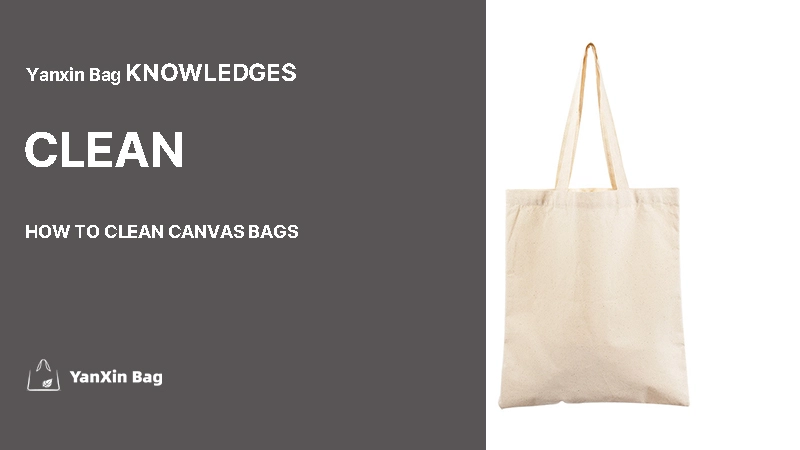
If you want to learn more about the pros and cons of cotton canvas bags, click here to read our article: Pros and Cons of Canvas Bags
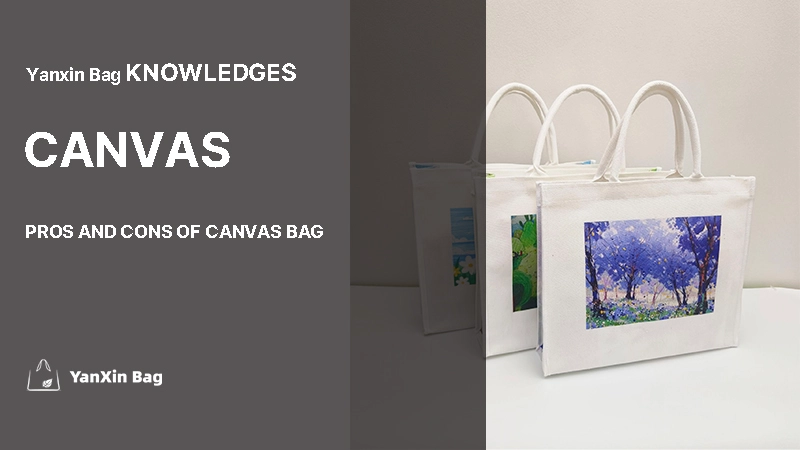
If you want to learn more about the pros and cons of cotton canvas bags, click here to read our article: Pros and Cons of Canvas Bags
Simple and Textured Tote Bag Material: Jute
Jute is a simple and textured material for tote bags, with a natural fiber texture and a rugged appearance. As a natural plant fiber, jute not only offers good durability and breathability but is also commonly used for eco-friendly shopping bags and handbags. It is favored by consumers who are conscious of sustainability and natural style. To enhance its water resistance, jute tote bags are often lined with a waterproof PE film, which not only prevents moisture penetration but also makes the bags sturdier and more structured.
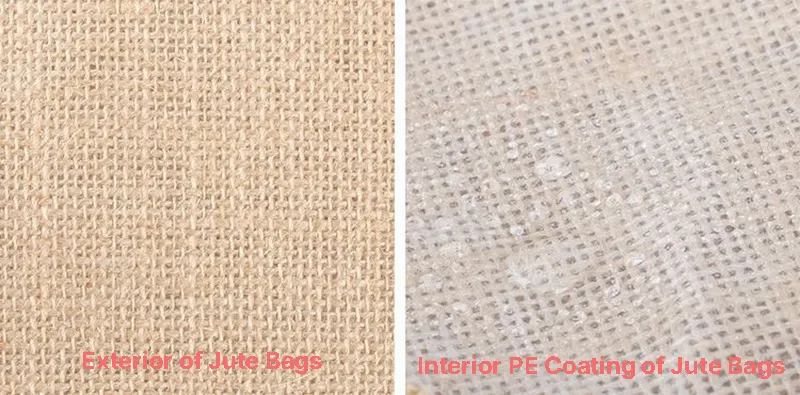
Main Advantages of Jute Tote Bags:
Eco-Friendly: Jute is inherently eco-friendly and biodegradable, meaning it breaks down quickly after use, making it environmentally friendly. Jute bags help reduce the use of plastic bags and support sustainable environmental goals. While the PE coating is not as eco-friendly as the natural material, its addition greatly extends the lifespan of jute bags, effectively reducing resource waste and pollution.
Low Environmental Impact, Carbon Footprint:
Jute has a low environmental impact because it requires less water, pesticides, and herbicides to grow compared to crops like cotton. Additionally, jute plants can improve soil fertility, support better crop rotation, and promote sustainable farming practices. Jute plants are very efficient at absorbing carbon dioxide, capturing more CO2 than many other plants. Therefore, growing jute helps lower greenhouse gas levels.
Natural Appearance: Jute bags have a rough, natural texture, giving them a rustic style that makes them perfect for fashion shopping bags or home decorations. Their natural design makes them especially popular among environmentally conscious consumers.
Weight and Texture: Jute bags are relatively heavy, which not only makes them more durable but also gives them a unique texture. Compared to lightweight plastic bags or other materials, the weight of jute bags gives a sense of high quality, both visually and tactically. This natural weight makes jute bags ideal for carrying heavy items while also showcasing a rustic elegance and simplicity. They appeal to consumers who appreciate an eco-friendly and natural look. Whether as a fashion accessory or for everyday use, the weight and texture of jute bags add a unique charm and high-quality feel.
Waste Reuse: Jute’s natural fibers can be repurposed as organic material for gardening, especially suitable for plant pots. This reuse not only reduces resource waste but also provides good breathability for plants, promoting their healthy growth.
Main Disadvantages of Jute Tote Bags:
Not Machine Washable, Prone to Shrinking: Jute bags may shrink due to washing or exposure to high temperatures, especially if not properly cared for. This could cause the bag to become smaller and less practical to use.
Prone to Molding: Another potential drawback of jute bags is their tendency to mold when exposed to moisture, especially in humid or damp environments. As a natural fiber, jute can create an ideal environment for mold growth if not stored properly. If you live in a humid area or need to store jute bags in a damp environment, this could be an issue. To reduce the risk of mold, proper care and maintenance are required, including regular cleaning and storing in a dry, well-ventilated area. Failure to maintain the bags properly can lead to degradation and even the growth of harmful microorganisms.
Not Wrinkle-Resistant: Jute bags do not recover from folding as easily as canvas or polyester bags. Therefore, it’s best to store them flat rather than folded to avoid affecting their appearance.
Limited Style Options: Jute, being a natural plant fiber, has a thicker texture, which can limit its design possibilities. It generally presents a more simple and rugged appearance, making it less suitable for intricate or detailed style designs.

If you want to learn more about the detailed steps and tips for cleaning cotton canvas bags, click here to read our article: How to clean canvas bags

If you want to learn more about the pros and cons of cotton canvas bags, click here to read our article: Pros and Cons of Canvas Bags
Trendy and Practical Tote Bag Material: Tyvek
Tyvek bags are made from high-density polyethylene material (Tyvek) developed by DuPont. This material combines the lightweight nature of paper with the durability of fabric. It uniquely integrates the benefits of paper, film, and fabric, offering features like lightness, tear resistance, waterproofing, breathability, and eco-friendliness. Tyvek bags are reusable and environmentally friendly, making them a practical choice for packaging, logistics, and shopping. Their excellent performance, unique appearance, and texture make them highly favored by designers and provide consumers with a high-performance, distinctive option.
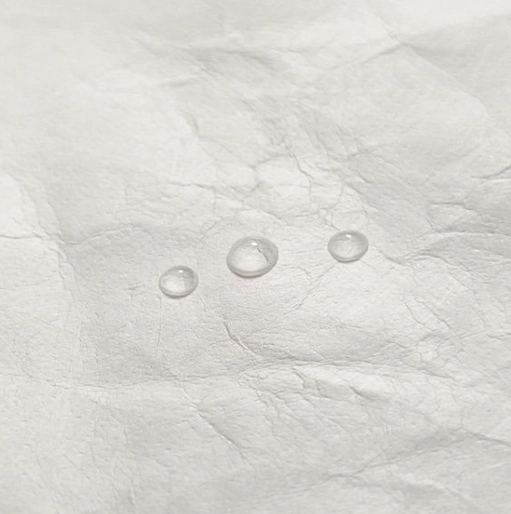
Main Advantages of Tyvek Tote Bags:
Easy to Clean: Tyvek bags have a smooth surface, are waterproof, and stain-resistant. They are easy to wipe and clean, making them perfect for everyday use, especially for shopping bags, where ease of cleaning is an important feature for consumers.
High Durability: Tyvek bags are made from tough material, tear-resistant, and wear-resistant. They can withstand repeated use, heavy loads, and daily friction without damage, making them suitable for long-term use in shopping and daily carrying.
Waterproof and Stain-Resistant: Tyvek bags are waterproof and stain-resistant. Even on rainy days or after accidental splashes, they protect the contents from getting wet. They are also easy to clean and keep dry, making them ideal for everyday shopping and outdoor use.
Breathability: Despite being waterproof, Tyvek bags remain breathable, which is particularly useful when storing items like fruits and vegetables. It helps to keep food fresh and extends the shelf life of items.
UV Resistance and Fade-Resistance: Tyvek bags are resistant to fading and have good UV resistance. Even after prolonged sun exposure, they maintain their color and print integrity, making them suitable for long-term use while ensuring that brand logos and designs remain clear and visible when exposed to the outdoors.
Unique Texture and Appearance: Tyvek has a unique texture that lies somewhere between paper and fabric. It’s both stylish and minimalist, making it an ideal material for eco-friendly shopping bags. It offers consumers a high-end, fashionable shopping experience while enhancing the added value of the brand.
Main Disadvantages of Tyvek Tote Bags:
Low Heat Resistance: Tyvek softens at around 135°C (275°F). The material may get damaged in high temperatures. Therefore, users should avoid exposing the bag to excessive heat to maintain its durability.
Higher Price: While Tyvek tote bags offer many advantages, they tend to be slightly more expensive than other tote bags.
Conclusion
In conclusion, selecting the most suitable tote bag material requires consideration of multiple factors, including the usage scenario, environmental friendliness, durability, and comfort of the material. Non-woven fabric is ideal for low-cost and short-term use, while cotton and canvas are popular choices for daily use due to their natural eco-friendliness and strength. Tyvek, with its unique texture and waterproof properties, is becoming a new favorite in the fashion world, while polyester is suitable for the fast-paced modern lifestyle due to its lightness and versatility.
If you are looking for high-quality tote bags to meet your needs, feel free to contact us! Yanxin Bag offers a variety of material options, including eco-friendly non-woven fabric, woven fabric, RPET, cotton, canvas, polyester, DuPont paper, washable kraft paper, and more. These materials are suitable for shopping, promotions, branding, and many other scenarios. We also provide customization services, allowing you to select materials, colors, sizes, and printing designs based on your brand’s needs to create a personalized tote bag.
Contact Yanxin Bag today to get free design consultations and samples, and create personalized tote bags that elevate your brand image!
FAQs of Tote Bags
Q1: What are the key uses of tote bags?
Answer: Tote bags are versatile and used for a variety of purposes, including shopping, commuting, carrying gym or beach essentials, and as a travel carry-on bag.
Q2: Why are tote bags considered eco-friendly?
Answer: Tote bags are reusable and often made from sustainable materials, which helps reduce the use of single-use plastic bags and minimizes environmental impact.
Q3: What are the different closure options available for tote bags?
Answer: Tote bags can have various closure options, such as open-top, zipper, velcro, or snap buttons, depending on the user’s security and convenience needs.
Q4: How do I choose the right size tote bag?
Answer: Select a tote bag size based on your intended use. Small sizes are great for light carrying, medium sizes work for daily shopping or commuting, and large sizes are ideal for bulk items or travel.
Q5: What is the origin of the term “tote bag”?
Answer: The term “tote” originated in the 17th century and means “to carry.” The tote bag evolved from being a utility bag for carrying items to a popular everyday accessory.
Q6: How do you measure a tote bag?
To measure a tote bag, you need to consider three key dimensions: the length (top to bottom), the width (side to side), and the depth (if applicable, for gusseted bags). These measurements will give you a good understanding of the size and fit for your needs.
Q7: How do you measure the straps of a tote bag?
To measure the straps, you should measure from where the straps attach to the bag to the top of the strap. This is typically done by measuring from the seam where the straps are sewn onto the bag.
Q8: What is the difference between tote bags and shoulder bags?
Answer: Tote bags are typically larger with two parallel handles and an open, spacious interior, making them ideal for carrying numerous or larger items. Shoulder bags, on the other hand, usually have a single strap designed to be worn over one shoulder and often feature multiple compartments for better organization.
Additional Resources
You can learn more detailed information about what nonwoven fabric is on Wikipedia.
You can learn more detailed information about tyvek material on Dupont homepage.
You can learn more detailed information about what RPET is on Wikipedia.
You can learn more detailed information about tote bag on Wikipedia.
For detailed information on different printing techniques, visit Printing News.
Note: Tyvek® and DuPont™ are trademarks or registered trademarks of Dupont or affiliated companies of DuPont.

